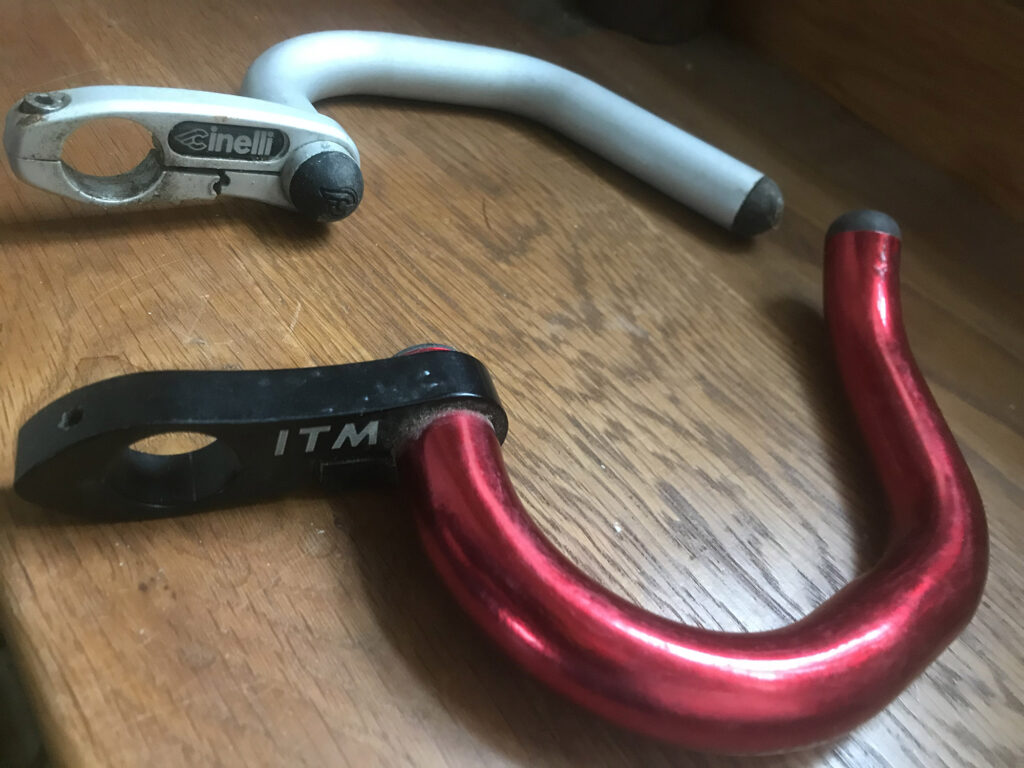Words by William Fotheringham | Photo: SWpix.com
Anyone who raced in the mid-1990s would have smiled at the announcement from the UCI last week that they were going to ban professional riders from descending in the “super-tuck” sitting on the top tube position, and from using the “fake tri-bars” position in which the rider drops their forearms onto the top of the bars and bungs their hands together as if in prayer.
In the early to mid-1990s, the Spinaci and Tiramisù bars produced by Cinelli and ITM were all the rage, well down into the amateur ranks. Little, simple extensions turned into mini jewels of design that clipped onto the bars (I was very upset never to get hold of a drilled out variant).
The modus operandi in a race was pretty well set. You’d attack or move up the side of bunch on the drops of the bars, and the instant you were clear of “traffic”, you whipped your hands onto the Spinacis, dropped forearms onto the top of the bars and you went aero. It was probably quicker, it definitely felt quicker, and your weight was, of course, safely supported.
It would have been pretty dumb to get into the Spinaci position when sitting tight on a wheel – although you could in extremis whip one hand across to the brake lever while keeping the other on the Spinacus – and I don’t remember seeing anyone in the amateur races I rode doing that. I don’t recall catching sight of any of the pro riders doing that either while watching the Classics and the Tour de France.
Nor do I recall seeing anyone crashing while actually using the aero position, although one thing was pretty obvious: you didn’t want to hit a pothole with your hands out front – it never felt as if you could control the bike as safely as you could with hands on the brake levers or the drops, and bunny hopping felt like a no-no unless you were super confident or skilled. You could steer the bike while in the aero position, but it was a nuanced business.

Still, I liked my Spinacis, apart from one thing. They made the front end of the bike look very busy, at a time when floppy brake cables were only a recent memory and everyone was trying to get a sleek aero look to their bike. They didn’t look as bad, however, as the Scott Drop-In bars that Greg LeMond pioneered in the early 90s. I’ve still got a pair of those lurking in my garage and they now remind me of a gate covered in candyfloss. Perhaps putting pink fluo bar tape on them was pushing the boundaries of taste a little bit too far.
There was general dismay when the UCI banned Spinacis and Tiramisùs, not least from Cinelli and ITM. (The Drop-Ins were dropped in 1992 I seem to recall.) The governing body’s move came after a spate of massive crashes in the 1997 Tour de France. It was all about ensuring rider safety and reducing race speeds, we were told, although I wouldn’t say, over the years, there was any reduction in either speed or pile-ups. I don’t recall any evidence being presented around either argument. They were just banned. Full stop.
In fact, my hunch now would be that the Spinaci ban stemmed from the then UCI head, the late Hein Verbruggen’s dislike of all things that smacked of progress and aerodynamics. This was the era when Verbruggen ran on to the track at a world championship to prevent Graeme Obree from riding in an unconventional aero position, and where the Hour Record was briefly, and bizarrely, set back to the Merckx era in a Luddite attempt to turn the aerodynamic clock back. I suspect that Uncle Hein simply didn’t like the way Spinacis looked.
Which all makes me wonder about why I have no issue with the UCI banning sitting on the top tube or the “virtual” tri-bar position. To the best of my knowledge, neither position has caused a crash, certainly in the pro ranks. And I’ve happily raced using kit which has been banned on safety grounds, albeit with no more evidence in favour of a ban than in this latest case.
Then again, I’ve been terrified both in races and on training rides by amateurs adopting both the newly banned positions, though fortunately not at the same time. The ones that stick in the mind are a third cat road race where guys were sitting on the top tube on downhills that must have been all of 5% – because they could – and a training line-out down a very wet road with potholes and drain covers where one of our number insisted on constantly riding “virtual”. Because he could.
As a race organiser, I’ve had discussions with commissaires about stopping amateur riders from sitting on the top tube: the commissaires weren’t keen on them using the position either and would brief riders not to do it. But those riders could always argue – as did my acquaintance on that wet training ride – “but the pros do it.” With that defence gone, and no more TV images of the pros doing it – no matter how safely – the practices should die a death.
So I’m with Matteo Trentin on this one: whatever the moans from pros who will be inconvenienced – and possibly fined – in the short term, perhaps the UCI have actually got ahead of the game for once, and have scotched these practices before they become completely, dangerously, ubiquitous. The Spinacis were lost in a corner of my garage, and maybe the Supertuck and “going virtual aero” will end up in similar obscurity.

